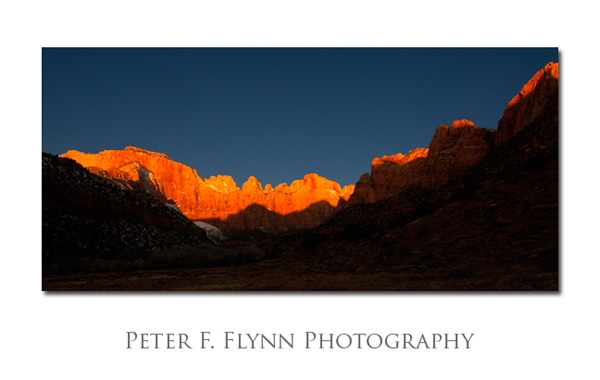 The Towers of the Virgin at dawn are arguably the most excellent scene in Zion NP. The Towers lie at the back of a large meadow in one of the main valley spurs. They are best viewed from behind the Zion Human History Museum, which can most easily be reached from around the north side of the building. The image was made on January 18 at around 9 am. Given the time of year and the fact that one must wait until the angle of the sun must first clear the west valley wall, this seemingly late hour worked out pretty well. During winter months, dawn is frequently accompanied by a stiff breeze that blows southerly down the valley. Thus a sturdy tripod and decent winter ware (gloves!) are both a must. Some of you will consider that the foreground is too dark, or perhaps that the Towers are too bright, or both. Visualization. Assuming that you have a properly calibrated monitor, the image you see is as close as I can get to the way the scene looked to me when the bits hit the Lexar.
The Towers of the Virgin at dawn are arguably the most excellent scene in Zion NP. The Towers lie at the back of a large meadow in one of the main valley spurs. They are best viewed from behind the Zion Human History Museum, which can most easily be reached from around the north side of the building. The image was made on January 18 at around 9 am. Given the time of year and the fact that one must wait until the angle of the sun must first clear the west valley wall, this seemingly late hour worked out pretty well. During winter months, dawn is frequently accompanied by a stiff breeze that blows southerly down the valley. Thus a sturdy tripod and decent winter ware (gloves!) are both a must. Some of you will consider that the foreground is too dark, or perhaps that the Towers are too bright, or both. Visualization. Assuming that you have a properly calibrated monitor, the image you see is as close as I can get to the way the scene looked to me when the bits hit the Lexar.
Now for the technical stuff. The image is the product of High Dynamic Range (HDR) engineering. The basic idea is that there is a limitation to all current image display modes compared to the inherent dynamic range of human vision – this includes photographic film and printing papers and video monitors. Dynamic range can be thought of as the variation between the brightest and darkest regions of a scene that can be perceived. We need also to toss in the allied notion of the sort of number of subtle variations in brightness between the extreme of lightness and darkness. Now it gets a bit gnarly. First we need to define a parameter known as the Exposure Value (EV). The EV has a standardized definition (ISO) in which EV equals to zero corresponds to an aperture (f-stop if you like) of 1, a shutter speed of 1 second at a media sensitivity value (ISO) of 100. The human visual system has a relatively large dynamic range, spanning more than 14 EV. This is far greater than the range that can be reproduced by the best photographic printing paper, which is about 6 EV, or even HDR displays that can reproduce a variation of up 9 EV. The basic idea behind HDR imaging (HDRI) is that images can be combined to expand the range well beyond that of any of the individual images. Hmm. What is the point of generating hypothetical image files that cannot be properly reproduced on printing paper or video? First, using a process known as Tone Mapping we can expand the apparent EV range in a sort of esthetically acceptable and relatively low noise way. This conversion allows us to exploit the display media to its fullest extent (yeah, this is a bit oversimplified). Secondly, although the EV range for printing paper is already fully optimized, there is a very real possibility that HDR video technology will continue to move into the mainstream.
The image above was generated by combining individual images spanning 5 EV (all at f/16 from 1/8s to 1/125s). Wait, you observe, isn’t this within the range that can be reproduced by film/paper/video. Yes it is, and this brings us to another use of HDR technology, which is to minimize the need for layer masks. Proper rendering of images like the one above; which are composed of adjacent very bright and dark regions, requires working up very precise layer masks, which are time consuming and extremely tedious. In the old days it would have been dodging and burning, but I seriously must doubt that anyone ever possessed the technical darkroom skill to render an image such as this one (sorry Ansel). White balance was set using the WhiBal card. A version of the image recorded at f/16, 1/125s (EV=15) was converted using daylight white balance to more accurately reproduce the sky behind the Towers – this image was added to the tone-mapped, HDR image using one of those tedious layer masks I mentioned. Tone mapping was accomplished using Photomatix (HDRsoft). More HDR images and discussion to follow – God help us.
For more information I can recommend the excellent books by Christian Bloch and Ferrel McCollough, and the tutorials available on the HDRsoft website.
Tags: dawn, HDR, HDRI, High Dynamic Range, Towers of the Virgin, Zion